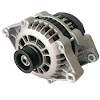Lightning Arresters
A lightning Arrester is a protective device which conducts the high voltage surge on the power system network to the ground.
Lightning Arrester will performer the following functions under different conditions,
1. During normal operation conditions, the lightning arrester is OFF the line, i.e., it will not allow any current to earth.
2. During the over voltage occurrence, the air insulation across the gap breaks down and an arc is formed, providing a low resistance path for the surge to the ground. In this way excess change on the line due to the surge is conducted to the ground through the lightning Arrester.
In substations the lightning Arresters are installed on both sides of the transformer i.e., on H.V. and L.V. side.
Usually the following type lightning Arresters are employed in substations, namely
1. Valve type 2. Thyrite type
Insulators
The insulators serve two purposes. They support the conductors and confine the current to the conductors.
There are several types of insulators used in substations depending upon the service requirement namely.
1. Pin type
2. Suspension type (or) strain type (or) disc type
3. Post insulator
4. Bushing etc.
In pin type insulator a groove is placed on top side of the insulator for housing the conductor. This type of insulators are used upto 33kv.
For operation voltage above 33kv the PIN insulators are uneconomical. Hence suspension insulators are used for above 33kv. It consists of a number of Disc insulators connected in series by metal links in the form of a string. The conductor is suspended at the bottom end of string.
A post insulator consists of porcelain body, cast iron cap and flanged cast iron base as these are directly connected to bus-bar clamp.
A Bushing insulator consists of porcelain-shell body. It mainly consists of washers at the top and bottom for fixing the position of bus-bar (or) rod in shell and mounting flange with holes drilled for fixing bolts and supplied with an earth bolt.
Cables
In Substations all the relays and measuring instruments are operated at 110 volt (or) 220 volt. For this purpose cables of 600 volt insulation grade are generally used and these are layed in trenches, cable trays and in some times in conduits. Usually P.V.C. Cables are Used in substations.
Fire Fighting Equipment
Generally the substations are provided with an adequate capacity of fire fighting equipments. Fire fighting equipment installed are
1. Cylinders of carbondioxide. 2. Sand and water buckets.
All the fire fighting equipments are placed conveniently and painted with Red color paint for the purpose of easy identiication.
Substation Auxiliary
Supply
In a substation, it is used practice to connect two transformers to 11kv main bus bars for the purpose of supplying the power to substation auxiliary equipments at a voltage of 400 volt and 230 volt.
The auxiliary equipments in substations mainly comprise of lighting circuits in the switching yard, Air blast fan for cooling the power transformer, battery changing sets, compressor units, ventilating fans substations building, water supply schemes are heating system equipment.












0 Comments